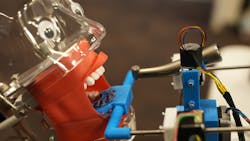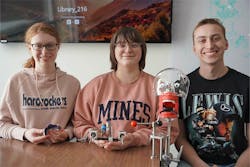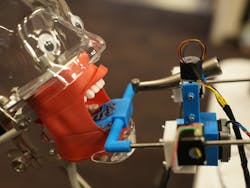STEM students design initial prototype for remote robotic dentistry
A team of senior biomedical engineering students at South Dakota Mines, a small STEM university in South Dakota, has spent the last year working with a dentist to build an initial prototype enabling remote robotic dentistry.
It all started with Dr. Chad Carpenter, a Rapid City, South Dakota, dentist who often serves rural and isolated communities in the state. Many of Dr. Carpenter’s patients live where local dentists are few and far between. He realized that increasing the ability to do remote dentistry could help increase access to dental care in these underserved communities.
The vision
The goal is to create an automated device that can be set up by a hygienist inside a local facility. This sort of device could enable a dentist to remotely oversee the work, such as filling a cavity, using the robotic extension.
“We’re trying to automate the drilling of cavities,” says Logan Jundt. “The end goal is to have a 3D-printed filling ready to be inserted into a predetermined cutting pathway.”
You might also be interested in …
ChatGPT: Will it revolutionize the dental industry?
Success in 7 Minutes: Yomi by Neocis
The team notes that modern dentistry already employs complex and highly detailed 3D scans of the mouth and all the teeth, so a procedure such as a filling could be planned out in the digital realm well in advance of any procedure.
“The dentist could be there for the initial consult, use the scans of the patient, and the robot could automate the process,” adds Jillian Linder.
The final vision of this sort of product could benefit both dentists and patients. But team members recognize that building a dental robot is a daunting task. They hope their prototype is the first of many to come in the years of product development ahead.
“It’s been quite the process and it’s been really fun exploring this challenge,” says Kara Huse. The team sourced many resources from across campus to build this initial prototype.
How it works
The team’s prototype uses custom 3D-printed dental impression trays to secure the automated device to the mouth. The device includes a dental handpiece with three dimensions of movement to access the area that needs attention.
“This design was kind of inspired off how a 3D printer moves, but this device would be mounted to the mouth,” says Jundt.
Some parts of the device are 3D printed specifically for each patient. This way they can be disposed of after each procedure to avoid the need for sterilization between each use. “A future team could also explore utilizing a self-stabilizing arm to drill cavities,” Linder adds.
Will robots be accepted in dentistry?
The team recognizes that part of the challenge here is the stigma around both dentists and robots.
“It's kind of a scary concept for some people, but people are becoming more accustomed to robotics over time,” says Jundt. The team believes that as robots become more accepted, it’s possible they could someday be more trusted than humans for procedures like this.
Team members also point out that Food and Drug Administration approval for new biomedical devices can take decades. They recognize their prototype is just an initial step in a device that could take many years to implement. At the same time, they have enjoyed the challenges of this project.
“It’s been a lot of fun, and Dr. Carpenter and his dental team have been a huge help,” says Huse. “We are excited to hand off the work we did over the past year to the next team in the coming year,” says Linder. “Where this can go is the most exciting part. We are just starting the foundation here but so much could be added with advanced robotics, computer vision, and machine learning,” Jundt adds.
This team is part of the first undergraduate cohort of the newly formed Department of Nanoscience & Biomedical Engineering at South Dakota Mines. “I think it's noteworthy that our first incoming class of students are doing such a great job in senior design,” says Scott Wood, PhD, the team’s advisor and an assistant professor in the department. “This is one of many examples of amazing research happening on all levels of our new and rapidly growing department.”
Editor’s note: This article first appeared in Through the Loupes newsletter, a publication of the Endeavor Business Media Dental Group. Read more articles and subscribe to Through the Loupes.
About the Author
Students from South Dakota Mines
Founded in 1885, South Dakota Mines is one of the nation’s leading engineering, science, and technology universities. The university enrolls 2,493 students with an average class size of 24. Placement rate for graduates is 97%. South Dakota Mines is ranked among the best engineering schools in the US for return on investment. Visit their website at sdsmt.edu.
Updated April 18, 2023


